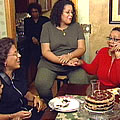What better way to honor National Library Week, (April 13-19) than starting your own book club! Here are some tips to get you started in the right direction. Remember, there is no right or wrong way to develop your book club, so don't stress out at the details.
Think about what your intentions are for your book club. Before you start looking for prospective members, sit down for a few minutes and ask yourself the following questions.
- Why are you starting a book club? What do you hope to get out of it?
- What type of people will make up the club? Are you hoping that all of you will have something in common (beside your love of books), or are you looking to form a diverse group?
- What types of books will your club primarily read? Fiction? Non-fiction? One particular genre or rotate through themes each month?
- Do you want to lead the club? If so, for how long, and how much time can you devote to organizing meetings, refreshments and discussions? If not, will other members be willing to take on these responsibilities?
- What are the minimum and maximum number of members your club can accommodate?
- When will your first meeting take place? How often will your club meet afterward? What about the summer months, and during the winter holidays?
Now that you have a clear vision of what you want for your book club, it will be easier to find others who want the same experience.
How to Host
If you and several friends are already interested in forming a book club, congratulations! Your book club is already well on its way.
When prospective members contact you for more information, explain the purpose of the book club and the number of members you're looking for. Interview them briefly about the types of books they like to read, and why they're interested in joining a book club. Let them know when and where the first meeting will be held, and ask them to bring two book suggestions to the meeting.
The Meeting Place
The location of your book club meetings—a restaurant, library, or your living room—will influence the number of members in the club and vice versa.
If it's in your home, you might want to keep it to eight or less. Ideally, no one member will have to host every meeting of the club. Club members are often willing—and usually eager—to host a meeting of the club at their house.
Still, no one should feel obligated to host a meeting in their home. Aside from hosting, there are
other ways members can get involved when the club gets together. If you're hosting in someone's home, decide if refreshments will be served.
If your library has a meeting room available, you may want to open up the club to 12 or more members. Other options for larger book clubs include meeting areas at bookstores, churches, YMCAs, restaurants or hotels.
Your Virtual Meeting Place
Online book clubs are growing in popularity, and you can invite friends from around the world to join you. As an Oprah.com member, you can
start your own discussion thread anytime. You never have to worry about a meeting space, appetizers or cleaning up—and your favorite people can drop in anytime!
Now comes the good part: meeting with your book club! Invite members to the first meeting at least two weeks before the date you've selected. Whether you contact them by phone, e-mail or the web, let them know when and where the first meeting will be held. Recommend that everyone has read at least one chapter and has at least one question they'd like the club to discuss.
Before everyone arrives, take a look at these ideas to help make sure everything runs smoothly. You and the other members will be deciding on a few important issues:
- Who will lead the book club meetings?
- Will it be the same person every time, or the person who suggested the book?
- Is there a price limit to the books you'll be reading? Paperbacks only, for instance?
- Who will keep a record of all the books read, when they were discussed, and who suggested them?
- And if you are meeting in person: Where will subsequent meetings be held? In the same location, at the home of that meeting's leader, or in a community room somewhere else, like a library or bookstore?
- Will refreshments be served? Who will provide them? Will they be connected to the theme of the book being discussed?
Choosing a Book to Read
Take a vote. After everyone has presented their suggestions take a vote on each title. If you have a tie, have another vote.
Simply take turns. Go alphabetically, by birthdays, or by whatever order you decide. Whoever's turn it is selects the next book to be read.
Take a blind vote. This is a little more time consuming, but allows everyone to cast their vote anonymously. Distribute several small slips of paper to everyone at the meeting. Vote on each title under consideration by passing around a large bowl and having everyone put in a slip with "yes" or "no" written on it. The title with the most "yes" votes wins.
Leave it to providence. Still have those slips of paper and a bowl handy? Use them to write down the title of each book, then put them all in the bowl and have someone pick one (or more).
Having discussion questions before your book club meets will help facilitate a good discussion of your book. As you read each novel, jot down page numbers and passages that moved you and where you found answers to the Oprah.com discussion questions. That way, you can easily share them with the group later on.
Start the Conversation
Don't feel you have to talk about each question! If the group doesn't have a lot to say about a topic or doesn't seem interested in the question, move on to a question that gets them talking. Or better yet, see if any one in the group has a question they'd like to discuss.
Looking for some questions to get the conversation rolling?
1. Get printable versions of the discussion questions from some of
Oprah's Book Club selections!
Grow Your Club
Once your club is up and running, create an online component to your club. Post meeting reminders for your book club, discuss who's bringing what snacks or simply encourage each other to read the assigned chapters!
Whether in person or over e-mail, when new members contact you for more information about joining your book club, interview them briefly about their experience with books and why they're interested in joining your club. Let them know about the current members and where your book club will meet.
Happy reading!



